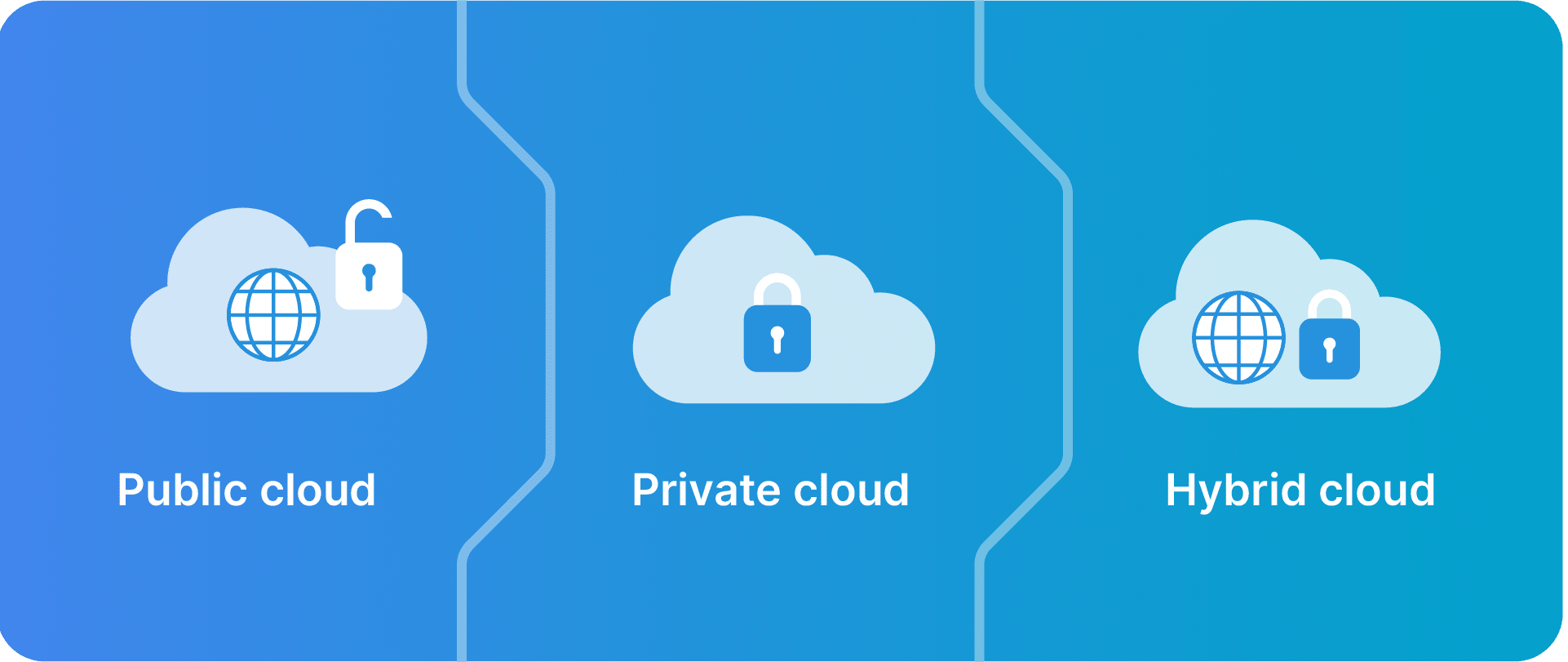Are you grappling with the challenges of scaling your company’s IT infrastructure to keep pace with your business growth? Look no further – cloud transformation has emerged as the go-to solution, rapidly gaining traction across businesses of all sizes and in every industry.
Embracing cloud technology isn’t just a trend; it’s a strategic action modern online businesses must take to become more agile, efficient, and competitive. However, while companies can harness the power of cloud computing to explore data, accelerate innovation, and respond swiftly to market demands, the path to cloud success is complex. It requires meticulous planning, strategic thinking, and a well-crafted roadmap.
With this in mind, this article will cover all that you need to get started. It will delve into the top five tips for designing a cloud-smart transformation strategy, guiding you to maximize your return on investment and position your business for sustained success and growth.
From setting a clear vision to prioritizing security and compliance, these tips will help you navigate the intricacies of cloud adoption with confidence, enhancing productivity, reducing costs, strengthening security, and fostering overall growth!
What is cloud transformation?
In essence, the cloud refers to the delivery of computing services – storage, servers, databases, networking, software, analytics, and intelligence – over the internet.
When you start your company’s cloud transformation (cloud migration or cloud adoption), you’re essentially moving your IT resources, data, applications, and workloads from on-premises to cloud-based environments. This transformation allows businesses to leverage cloud computing services to enhance agility, scalability, flexibility, and cost-effectiveness.
By shifting from traditional, on-premises infrastructure to cloud-based solutions, companies can reduce the burden of managing physical servers and data centers to redirect resources and focus on their core competencies. In fact, according to a report by Flexera, 92% of organizations have already embraced a multi-cloud strategy due to the compelling reasons and advantages listed below.
Benefits of implementing a cloud-smart transformation strategy
- Cost-effective: The pay-as-you-go pricing models of cloud services enable businesses to only pay for what they use. This provides transparency and contributes to tangible cost savings, particularly for startups and small and midsized enterprises (SMEs).
- Scalability: For businesses experiencing fluctuating demands or those on an expansion spree, adopting a cloud model can enable companies to leverage cloud resources that they can seamlessly scale up or down according to demand.
- Innovation and competitiveness: With access to the latest technologies and tools through the cloud, businesses can foster a culture of innovation, enabling them to outshine competition.
Stages and components of a successful cloud transformation
To harness the full potential of cloud computing, you need a well-defined strategy that covers the stages and components of a successful cloud transformation procedure.
Step 1: Conduct a thorough assessment
Before embarking on any transformation journey, you need a clear understanding of where your business currently stands. This initial assessment involves evaluating your existing IT infrastructure, applications, data, and workloads to determine your organization’s cloud migration readiness.
Here’s a blueprint of the key actions for this stage:
- Create an inventory: Catalog all your existing IT assets, applications, data, and workflows. Overall, this inventory should provide a comprehensive view of your current technology landscape. Ask yourself: what’s running where, and what is the current utilization?
- Identify business goals: Clearly define the goals and objectives the cloud transformation will support. These goals include cost reduction, scalability, agility, enhanced customer experiences, etc.
- Involve stakeholders: Cloud transformation isn’t an isolated IT project. Talk to not only the IT team but also stakeholders from various departments. To understand the broader business context, involve finance, marketing, operations, and other teams. Their insights can be invaluable in crafting a comprehensive strategy.
- Assess migration suitability: Assess which elements are prime candidates for migration to the cloud, which need modernization or optimization, and which should remain on-premises. This categorization helps in prioritizing efforts.
- Analyze cost: Understand the total cost of ownership (TCO) for your on-premises infrastructure. This includes hardware, software licenses, maintenance, and operational costs.
- Ensure security and compliance:Identify any security and compliance risks associated with your current setup. Are there vulnerabilities that need immediate attention?
- Evaluate the impact on employees and workflows: Finally, understand that cloud transformation affects not only technology but also people and processes. Knowing how this change will impact employees and workflows is crucial for planning a smooth transition. With this in mind, evaluate your team’s skillset. Do they have the expertise needed to manage a cloud environment?
With cloud transformation, it’s possible to encounter technical, financial, or organizational obstacles. This stage will allow you to prepare and plan for these hurdles by creating a comprehensive picture of your organization’s technology landscape. You’ll be able to set the stage for informed decision-making, pinpointing any barriers early, and developing strategies to overcome them.
To that end, businesses can employ cloud readiness assessment tools — specialized software designed to evaluate an organization’s readiness for adopting cloud technology. They automate the assessment process by collecting and analyzing data related to an organization’s existing IT infrastructure, applications, and data.
Cloud readiness assessment tools typically use a combination of surveys, questionnaires, and automated data collection mechanisms. They gather information on factors like the current hardware and software inventory, network configuration, data storage, and security protocols.
In addition, organizations can also leverage cloud readiness assessment techniques such as:
- Gap analysis: This method involves comparing the current state of an organization’s IT infrastructure, applications, and processes with the desired state in a cloud environment. It identifies the gaps or differences that need to be addressed for a successful cloud transformation.
- Proof of concept (PoC) projects: A PoC is a practical demonstration of the cloud’s feasibility for a specific use case or application. It involves deploying a limited-scale cloud environment to test how it performs in real-world conditions.
- Interviews and surveys: These entail engaging with stakeholders and employees to gather qualitative insights about the organization’s readiness for cloud transformation. Interviews and surveys capture the human element, providing insights that might not be apparent through automated tools alone. They also help in understanding the specific needs and concerns of different departments and individuals within the organization.
Step 2: Choose the right cloud model and service
It’s important to note that cloud models and cloud services are related concepts in the world of cloud computing, but they refer to different aspects of cloud technology. Here’s a breakdown of the key differences between the two:
Cloud models

Cloud models refer to different deployment options for hosting and delivering cloud services. These models define how cloud resources are physically deployed and managed. The main cloud deployment models are:
- Public cloud: In a public cloud, resources are owned and operated by a third-party cloud service provider and are made available to the general public over the Internet. Users share the same infrastructure and resources.
- Private cloud: A private cloud is dedicated to a single organization. It can be hosted on-premises or by a third-party provider but is isolated from other organizations’ resources, providing greater control and security.
- Hybrid cloud: Hybrid cloud combines elements of both public and private clouds. It allows data and applications to be shared between them while maintaining distinct environments. Organizations use hybrid clouds to balance flexibility and control.
Cloud services

Cloud services address the different types of computing services and resources that are provided over the cloud infrastructure. There are three primary models of cloud services:
- IaaS (Infrastructure-as-a-Service): IaaS provides virtualized computing resources over the Internet. For example, enterprises can rent virtual machines, storage, networking, and other infrastructure components. It offers the basic building blocks for building and managing cloud-based solutions. Companies are responsible for managing the operating system and software applications.
- PaaS (Platform-as-a-Service): PaaS offers a platform for developing, deploying, and managing applications without worrying about the underlying infrastructure. It abstracts the infrastructure layer, allowing developers to focus on coding and application logic. Examples include application hosting environments and databases.
- SaaS (Software-as-a-Service): SaaS delivers software applications over the Internet on a subscription basis. Organizations access these applications through web browsers, eliminating the need for local installations and maintenance. For instance, companies can employ email services, customer relationship management (CRM) software, and office productivity tools.
Choosing the right cloud model and service is a critical decision that should align with your business goals, technical capabilities, and specific requirements. Providers like Liquid Web can be an excellent choice for organizations seeking customizable, dedicated infrastructure with robust support options.
Step 3: Develop a comprehensive migration plan
When an organization transitions from one system or environment to another, a migration plan is necessary to ensure a structured and efficient migration process while minimizing risks and disruptions.
Here’s a breakdown of the key components of a migration plan:
Timelines
- Key milestones: Start by outlining the major phases of your migration project, such as planning, preparation, execution, and post-migration.
- Tasks and deadlines: Specify the tasks required for each phase and assign deadlines. These tasks can include infrastructure assessment, application inventory, testing, data migration, and post-migration validation.
- Testing schedule: Highlight the importance of testing and allocate sufficient time in the timeline for thorough testing. This will help in identifying and rectifying issues before they affect business operations, reducing downtime and potential revenue loss. This process should encompass compatibility testing, performance testing, and user acceptance testing.
Roles and responsibilities
- Team members: Clearly define who is involved in the migration process, including IT teams, project managers, vendors, and other stakeholders.
- Specific tasks: Assign specific responsibilities and tasks to individuals or teams. For example, infrastructure provisioning might fall under the purview of the IT department, while application configuration is the responsibility of the development team.
- Ownership: Ensure that each task has a designated owner who is accountable for its completion. This accountability helps streamline communication and troubleshooting during the migration.
Risk assessment and contingency
- Risk identification: Identify potential risks that may disrupt the migration process. These could include technical issues, resource constraints, or unexpected downtime.
- Contingency plans: Develop detailed contingency plans for each identified risk. Explain how the team should respond if a risk materializes, including backup plans, escalation procedures, and decision-making criteria. Having contingency plans in place helps mitigate the impact of unforeseen challenges.
Post-migration evaluation
- Assess success: After migration, evaluate the success of the cloud transformation against predefined success criteria and objectives. This assessment should include performance metrics, cost savings, and user satisfaction.
- Identify areas for improvement: Use the post-migration evaluation to identify areas for improvement. This might involve optimizing resource allocation, refining processes, or addressing any issues that arose during migration.
- Continuous improvement: The post-migration evaluation isn’t just a final step; it’s an opportunity to drive continuous improvement in your cloud environment and migration processes.
Step 4: Focus on security and compliance
While cloud transformation is a critical initiative for modern businesses that offers opportunities for growth and efficiency, it presents certain security and compliance challenges that require careful consideration.
- Data loss: Losing data due to unforeseen events can harm business operations. Robust data backup and recovery solutions, along with rigorous testing, are vital for ensuring data continuity.
- Data breaches: Unauthorized access to sensitive data can lead to data breaches, posing significant threats to an organization. With this in mind, implementing encryption, strong access controls, audits, and monitoring are key measures to prevent data breaches.
- Inadequate access management: Weak access controls can expose critical resources to unauthorized individuals. Strong identity and access management policies, along with multi-factor authentication, are essential for maintaining control.
- Vendor lock-in: Overreliance on a single cloud provider can limit flexibility and potentially increase costs. Accordingly, adopting multi-cloud or hybrid strategies and adhering to open standards can mitigate vendor lock-in risks.
- Compliance risks: Non-compliance with regulations can lead to legal and financial repercussions. Choosing compliant cloud providers, such as Liquid Web, adhering to best practices, and conducting regular audits are vital for compliance.
- Shared technology vulnerabilities: Shared infrastructure can expose organizations to vulnerabilities in other tenants’ services. Timely software updates, isolation techniques, and utilizing security services from the cloud provider can enhance security.
- Distributed denial of service (DDoS) attacks: DDoS attacks can disrupt cloud services. Employing DDoS protection measures such as traffic filtering and redundancy is necessary.
- Insecure APIs: Inadequately secured APIs can be exploited. Rigorous API security assessments and following best practices are imperative for API security.
- Insider threats: Insider actions, intentional or unintentional, can compromise security. User behavior analytics, monitoring, and clear security policies are key safeguards against insider threats.
- Misconfiguration: Misconfigured resources can create vulnerabilities. Leveraging automation tools, regular audits, and adhering to cloud provider best practices can prevent misconfigurations.
Step 5: Optimize for cost and performance
It’s important to ensure that you are getting the most value out of your cloud infrastructure while delivering the best possible user experience. Here is what you need to keep in mind:
- Right-sizing resources: This means selecting instance types, storage, and other resources that match your workload’s actual requirements. Over-provisioning can lead to unnecessary costs, while under-provisioning can result in performance issues.
- Leveraging reserved instances (RIs): RIs offer significant cost savings compared to On-Demand instances. By committing to a specific instance type and duration, you can lower your cloud computing expenses. Analyze your usage patterns and commit to RIs for predictable workloads to optimize costs effectively.
- Implementing auto-scaling: Auto-scaling allows your infrastructure to adjust resources automatically based on demand. During peak times, additional resources are provisioned, and during off-peak times, they are de-provisioned. This ensures optimal performance without overpaying for unused resources.
- Load balancing:Load balancing distributes incoming traffic across multiple instances, ensuring that no single instance is overwhelmed. This not only enhances performance by providing redundancy but also improves fault tolerance. It can also be used to route traffic to the most cost-effective instances.
- Continuous monitoring and management: Regularly analyze your usage patterns and use monitoring tools to identify resource bottlenecks and underutilized assets. To that end, cloud providers offer various monitoring and alerting services that can help you stay proactive. In particular, Liquid Web’s 24/7 customer support can play a significant role here. The support team can provide expert guidance on cost and performance optimization strategies, helping you make informed decisions while minimizing downtime and potential performance issues.
These five crucial steps are fundamental to embracing the cloud with confidence and agility, garnering substantial rewards.
Overcoming challenges in cloud transformation
Any significant shift in business operations, like cloud transformation, poses challenges that must be tackled with precision and efficiency.
Data security concerns
Businesses often worry about the security of their data when transitioning to the cloud due to the shared nature of cloud environments. To combat these obstacles, companies can:
- Choose reputable cloud service providers known for robust security measures, like Liquid Web.
- Encrypt data both in transit and at rest.
- Continuously monitor and audit security configurations to identify and address vulnerabilities.
Resistance to change
Employees may resist adopting new cloud technologies and processes, which can hinder the transformation process.
With this in mind, provide comprehensive training on the benefits and proper usage of cloud technologies to make it easier for them. Also, communicate the reasons behind the transition and the positive impacts on their job roles and work.
Lack of technical expertise
Organizations may lack the necessary in-house skills and expertise to effectively manage and optimize cloud resources.
In such a scenario, consider partnering with managed service providers (MSPs), like Liquid Web, that offer fully managed hosting services and 24/7 customer support. You can also invest in training programs and certifications for existing IT staff.
High initial costs
The upfront investment required for cloud migration and infrastructure setup can be a barrier for some businesses.
Conduct a thorough cost analysis to identify potential savings in the long run and utilize cloud providers’ pay-as-you-go pricing models to start with minimal upfront expenses.
The role of cloud service providers, like Liquid Web, cannot be underestimated here. They play a key role by offering secure, managed hosting services and round-the-clock support to facilitate a smooth transition to the cloud.
Future trends and predictions in cloud transformation
The future of cloud transformation is heavily influenced by emerging technologies and trends such as artificial intelligence (AI), machine learning (ML), and edge computing. These innovations are set to revolutionize the cloud landscape.
With a staggering 5.6 billion IoT devices expected to be used for data collection and processing through edge computing in enterprises and governments, the cloud will play a pivotal role in managing and analyzing this data efficiently.
Liquid Web is at the forefront of these trends, continuously innovating to offer cutting-edge solutions that empower businesses to harness the full potential of the cloud while navigating the evolving technology landscape. Boasting a comprehensive suite of services, Liquid Web empowers businesses to take optimal advantage of the AI influx, effectively manage vast IoT networks via edge computing, and anticipate potential security threats within their digital environment.
Cloud transformation vs cloud migration
Although the terms “cloud transformation” and “cloud migration” might seem similar and are indeed often used interchangeably, they have distinct meanings in the world of cloud computing.
Cloud migration specifically refers to the process of moving data, applications, and IT processes from an on-premise environment to the cloud. In essence, it’s a process of transferring assets to a cloud-based infrastructure without necessarily resulting in substantial systemic changes.
In contrast, cloud transformation is a broader and more extensive term. This concept includes not only the migration of data and applications but also a fundamental shift in how a business operates.
Embracing cloud transformation means modifying the way your organization handles operations, develops its corporate culture, formulates strategies, and utilizes technology.
For instance, a cloud transformation strategy might entail redesigning business workflows to foster a culture that encourages continuous learning about cloud technologies and maximizing the advantages of using cloud resources.
Cloud transformation vs digital transformation
Cloud transformation is a significant part of digital transformation, but it’s not the entirety of it. Digital transformation refers to the broader strategic initiative undertaken by businesses to utilize digital technologies and adopt digital processes across all facets of their operations. It’s a holistic strategy that necessitates a digital-first mindset for reconstructing organizational strategies, enhancing capabilities, and redesigning business models.
Conversely, cloud transformation is a more technical aspect and a critical subset of digital transformation. Specifically, it deals with the transition of a business’s data, applications, and IT infrastructures from on-premise systems to the cloud.
While cloud transformation is an essential part of a company’s digital transformation journey, there are other components of digital transformation, like:
- Enhancing customer experiences through digital channels.
- Adopting data analytics and artificial intelligence.
- Implementing agile methodologies in project management.
For example, a company could launch a digital transformation initiative that focuses primarily on adopting new collaborative tools or enhancing its digital marketing initiatives without necessarily moving its data and applications to the cloud.
Making the move to cloud transformation
In the grand mission of shifting towards cloud computing, the path might initially seem complex. However, it isn’t unachievable if you follow the five core stages that have been outlined in this guide.
And, of course, a reputable cloud service provider is a must for this endeavor. That’s where Liquid Web comes in!
Liquid Web is your trusted partner on this journey, with a suite of services resolving the multifaceted challenges of cloud transformation. Whether you need high-availability hosting for a consistently operational website or compliant solutions meticulously created for industries handling sensitive data, Liquid Web has you covered.
With its customizable dedicated infrastructure, Liquid Web offers a cloud solution that’s tailored specifically to your company’s needs. Even for organizations that aren’t tech-savvy, there’s no cause for concern. Liquid Web’s fully managed hosting makes sure that all your hosting requirements are met.
Additionally, services like the VMware private cloud provide transparency in pricing without per-VM fees, delivering an economical solution for entities managing multiple virtual machines along with a complimentary migration.
Are you ready for your cloud transformation journey? Contact Liquid Web today and harness a more resilient, cost-effective, and efficient cloud-driven future for your business!





